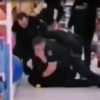KJIPUKTUK (Halifax) – Yesterday we heard of two pedestrians hit in full daylight, the first at 1.20 pm resulting in life threatening injuries on the corner of Clayton Park Road and Dunbrack, the second on Barrington Street just before 4.50 pm.
It’s not unusual for two pedestrians to be hit on Halifax roads in a day, also not rare for injuries to be serious or even fatal. Isn’t this just part and parcel of mobility in a city – every day someone will get hurt in a road traffic “accident”? No need to panic, just be careful?
I use the crosswalks at the intersection of Clayton Park Drive and Dunbrack frequently. It’s known as a safer route to take on foot from Fairview/Clayton Park up towards the Canada Games Centre and back. The alternative route is Lacewood, which is dangerous due to several intersections which I avoid at all costs – signalized intersections are the location of around 40% of all incidents in Halifax due to the extreme danger from turning traffic while the walk sign is on.
Despite this being a relatively safer crossing over Dunbrack from Clayton Park Drive, it’s still hazardous because Dunbrack is designed and used like a Highway. The presence of overhead lights doesn’t make the crossing safe. Drivers in the first traffic lane stop right up against the crosswalk lines, which then obscures your view of oncoming traffic in the second lane when you cross. Drivers often don’t stop at all – they are going too fast and perhaps don’t see pedestrians. The intersection crossing over Clayton Park Drive itself is also very dangerous because it’s far wider than necessary, which allows traffic to turn at speed and leaves you exposed for a long period while crossing.
Unfortunately, dangerously wide crossing points are extremely common in Halifax. What isn’t happening are efforts to adapt them so they’re safe for use. Road crossing points must acknowledge and meet our human vulnerabilities. They need to be extremely safe by design, simply because we aren’t built to withstand impact from vehicles.
That means adopting infrastructure we don’t currently have. For a Highway-style road like Dunbrack where drivers are comfortable cruising at 50 to 70kph, we need appropriate safety adaptations. This could include (for example) lights and lines which stop drivers in advance of the crosswalk so vehicles are far enough back to ensure everyone can see pedestrians crossing, and pedestrians can see vehicles in both lanes. Also reducing the traffic lane and crosswalk widths so drivers need to go carefully and slowly when they pass over the crosswalk – this is called a “pinch-point”.
This might all seem unnecessarily technical. Why can’t drivers just slow down, and pedestrians take more care? This is what we have mainly been saying and promoting in Halifax for decades – pedestrians/drivers just need to do x,y and z. A blame game happens after each and every incident (“why do pedestrians always step out in front of me?”, etc) and mainly we are satisfied that the cause is careless or dangerous behaviour by one or both parties. Yet nothing actually changes.
The reason why so many of us are hit on crosswalks here (accounting usually for around 60 to 70% of incidents) is because they invite too many errors by all road users. I can start crossing comfortably in lane one, then get in trouble when unexpected things happen in lane 3, 4 or 5. The more traffic movements there are from different directions and lanes, the easier it is for us all to make a mistake and the more likely it is that an incident will happen.
Our incident stats and personal experiences of constant close calls and danger on crosswalks (see facebook group HRM Safe Streets for Everyone) show our crosswalks simply aren’t fit for purpose – last year 65% of pedestrians were hit during daylight, when they should have been clearly visible. 53% of all pedestrian incidents happened in daylight during sunny and clear conditions.
Pedestrians aren’t qualified, professional road users. We make mistakes because we’re human and we include the elderly, children and people living with physical and learning disabilities. Road crossing points must be designed to prioritise our needs and abilities, not the needs of traffic flow.
Road safety particularly for the most vulnerable users of them is a human right, say the United Nations. This means it’s not down to political choices/discretion (“maintaining and building new roads is more important for our economy”, etc), it must be addressed with adequate funds, measures and a robust road safety plan.
We have money allocated for pedestrian infrastructure and a road safety framework, so won’t that help to fix the issue and make crosswalks safer? That can only happen by first assessing why our crosswalks are dangerous, then identifying what adaptations are needed to ensure they are safe and comfortable to use by people of all ages and abilities. This process must be completed in direct partnership with representative road users – children, the elderly and people with learning and physical disabilities in particular. Then the adaptations identified in that process need to be applied HRM wide, with an appropriate budget. This can and will reduce incidents, but we are not doing it.
Until this process happens, the Crosswalk Safety Society of Nova Scotia and like minded people will continue advocating for a plan of action and funding that squarely addresses our road safety crisis.
You can help by sending a link to this article to your local MLA, Councillor and MP by email, with a covering note requesting a response and appropriate action. Explain how safety would help you and your neighbours, family or friends. Ask that they initiate a funded road-user led road safety plan, with representative road users involved throughout the assessment, planning and implementation phases. Request that they do not just forward your message on to traffic staff. Ask them to explain how they themselves will progress road safety. They are in control, and they can act.
If you walk, cycle or use a wheelchair and are affected by road safety issues, please join HRM Safe Streets for Everyone. If your local crosswalk needs a crosswalk flag, please contact the Crosswalk Safety Society. Please remember to report issues affecting your safety to our municipal authorities using the 311 service.
With a special thanks to our generous donors who make publication of the Nova Scotia Advocate possible.
Subscribe to the Nova Scotia Advocate weekly digest and never miss an article again. It’s free!




Well said!